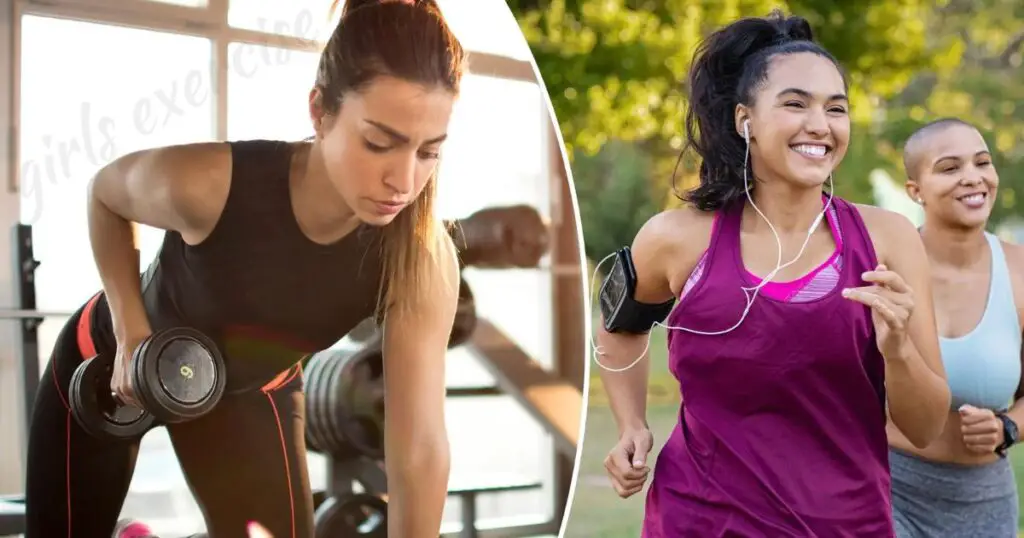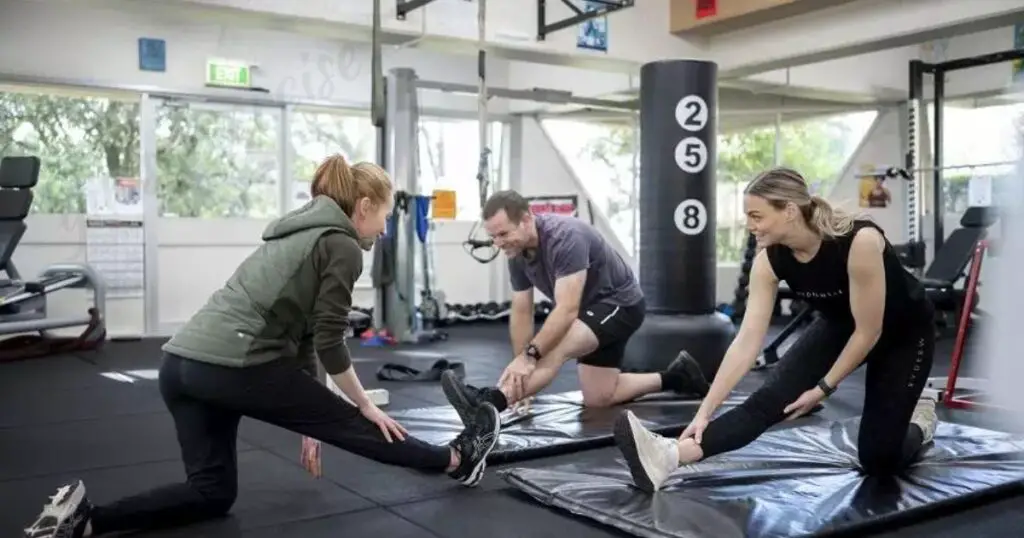Introducing the multifaceted benefits of exercise tailored for girls’ overall health and well-being is crucial. When it comes to “girl exercise for overall health and well-being,” a comprehensive approach encompasses various facets.
It’s about empowering girls through physical activity that fosters cardiovascular strength, muscle development, and flexibility. This tailored exercise routine extends beyond physical prowess, impacting mental health by reducing stress, boosting confidence, and enhancing cognitive abilities.
Exercise becomes a social platform, nurturing camaraderie and teamwork. This holistic approach doesn’t just cultivate a healthier physique; it lays the foundation for a resilient, empowered, and balanced life for girls.
Physical Benefits Of Exercise For Girls:

Enhancing Cardiovascular Health and Strength:
Regular physical activity significantly impacts cardiovascular health in girls. Engaging in exercises like jogging, cycling, or swimming strengthens the heart muscles, improves blood circulation, and enhances overall cardiovascular endurance.
As they participate in aerobic activities, their heart rate increases, promoting better oxygen flow throughout the body and reducing the risk of heart-related diseases. Exercise aids in maintaining healthy blood pressure levels.
For girls, particularly during puberty, when hormonal changes might affect their cardiovascular system, regular workouts contribute to stabilizing these fluctuations and promoting a healthier heart rate.
Strengthening Muscles, Bones, and Flexibility:
Physical exercise plays a pivotal role in building and strengthening muscles and bones, crucial during a girl’s developmental years. Weight-bearing activities such as running, dancing, or even simple bodyweight exercises like squats and lunges promote bone density, reducing the risk of osteoporosis later in life.
Incorporating flexibility exercises such as yoga or stretching routines enhances joint mobility and reduces the likelihood of injuries. For girls involved in various physical activities or sports, this flexibility is instrumental in preventing strains or sprains.
The detailed understanding of these physical benefits emphasizes the importance of exercise as a preventive measure against various health issues that might arise in adolescence and later in life. Regular physical activity not only strengthens the body but also sets the foundation for a healthier future.
It’s crucial to note that these benefits extend beyond physical appearance. While exercise may contribute to a more toned physique, its primary impact lies in the internal strengthening of vital bodily systems, ensuring girls are equipped with a robust foundation for their overall health and well-being.
Moreover, these physical benefits create a positive cycle: as girls witness the improvements in their physical capabilities, they often gain confidence and motivation to continue their exercise routines.
This perpetuates a cycle of better health choices, reinforcing the notion that exercise isn’t solely about appearance but about feeling strong, capable, and healthy from within.
Mental Health And Exercise For Girls:

Alleviating Stress and Anxiety:
Regular exercise plays a pivotal role in mitigating stress and anxiety among girls. Physical activity triggers the release of endorphins, neurotransmitters that act as natural mood elevators. These endorphins help alleviate stress, reduce feelings of anxiety, and contribute to an overall sense of well-being.
Moreover, for adolescent girls facing academic pressures or social challenges, exercise serves as a healthy outlet. Engaging in activities like running, yoga, or team sports allows them to release pent-up emotions, manage stress levels, and cultivate a more positive mindset.
Enhancing Self-Esteem and Emotional Well-being:
Exercise significantly impacts self-esteem and emotional health in girls. As they achieve fitness goals or improve their performance in physical activities, it boosts their confidence and sense of accomplishment. This sense of achievement translates beyond the realm of exercise, influencing how they perceive their capabilities in various aspects of life.
Exercise provides a structured routine and a sense of control, especially during times of uncertainty or change. For girls navigating the complexities of adolescence, having a consistent exercise regimen can offer stability and a sense of empowerment, contributing to emotional resilience.
Understanding the connection between mental health and exercise underscores the importance of physical activity beyond its physical benefits. It’s not just about improving physique; it’s about fostering mental resilience and providing girls with tools to navigate the challenges they might face during their formative years.
Encouraging exercise isn’t just about getting girls to move; it’s about promoting mental wellness, self-assurance, and emotional stability. Creating an environment where exercise is seen as a means of holistic well-being rather than a mere physical obligation is crucial in supporting the mental health of girls and ensuring their overall development.
Empowerment Through Exercise:

Cultivating Self-Efficacy and Confidence:
Exercise serves as a powerful tool for cultivating self-efficacy and confidence among girls. Setting and achieving fitness goals, whether it’s improving running endurance, or mastering a new yoga pose.
Or increasing strength through weightlifting, instilling a sense of accomplishment. As girls witness their progress, they develop a belief in their abilities to overcome challenges, both physical and mental.
This sense of achievement extends beyond the gym or sports field. It translates into various aspects of their lives, from academics to social interactions. By realizing their capacity to conquer physical hurdles, girls gain the confidence to tackle obstacles in other domains, fostering a resilient and empowered mindset.
Breaking Stereotypes and Fostering Independence:
Engaging in exercise breaks societal stereotypes surrounding girls’ capabilities and physical prowess. Participation in sports or rigorous workout routines challenges traditional gender norms, emphasizing strength, determination, and skill irrespective of gender.
Moreover, exercise promotes independence. By taking charge of their fitness journeys, girls learn to make decisions about their health and well-being. They become self-reliant in setting goals, planning workouts, and making choices that prioritize their physical and mental health.
Empowerment through exercise transcends the physical benefits. It’s about fostering a mindset that believes in one’s capabilities, challenges societal norms, and cultivates independence and resilience.
Empowerment through exercise also fosters a supportive community. In group workouts or team sports, girls learn the value of collaboration and support.
They celebrate each other’s achievements, creating an environment where encouragement and camaraderie thrive, enhancing not only their individual growth but also their ability to uplift others.
Social And Emotional Aspects Of Exercise:

Building Social Connections and Camaraderie:
Exercise, particularly in group settings or team sports, creates a platform for girls to build meaningful social connections. Participating in activities like group fitness classes, team sports, or running clubs fosters a sense of camaraderie.
It provides an opportunity for girls to bond over shared interests, experiences, and common fitness goals. Moreover, these social interactions extend beyond the workout sessions. They create a supportive network where girls can share experiences, offer encouragement, and forge lasting friendships.
These connections play a crucial role in their emotional well-being, providing a sense of belonging and support.
Developing Healthy Habits from a Young Age:
Engaging in regular exercise contributes significantly to emotional resilience and the development of coping skills. Physical activity acts as an outlet for stress, allowing girls to channel their emotions in a healthy manner.
Be it through a vigorous workout or a calming yoga session, exercise helps in managing emotions, reducing anxiety, and improving overall mood. Overcoming physical challenges during exercise translates to improved problem-solving skills in other areas of life.
When girls face hurdles in workouts or sports, they learn perseverance, resilience, and strategies to overcome obstacles. These coping mechanisms become invaluable tools in navigating life’s challenges, both on and off the exercise mat.
Understanding the social and emotional aspects of exercise highlights its role in creating a supportive environment for girls’ mental well-being. It’s not merely about physical exertion but about forging connections, finding emotional outlets, and developing crucial skills that contribute to their overall happiness and resilience.
Exercise also becomes a vehicle for emotional expression. For girls who might find it challenging to articulate their feelings, physical activity serves as a means of releasing pent-up emotions, promoting mental clarity, and fostering a sense of emotional balance.
Developing Healthy Habits From A Young Age:
Establishing a Foundation for Lifelong Wellness:
Encouraging the development of healthy habits from a young age lays the groundwork for a lifetime of well-being. Introducing children, including girls, to the importance of regular physical activity sets a precedent for prioritizing health throughout their lives.
When exercise becomes a normalized part of their routine, it ingrains the understanding that staying active is a fundamental component of a healthy lifestyle. Moreover, cultivating these habits early significantly reduces the likelihood of sedentary behavior in adulthood.
Girls who grow up accustomed to integrating exercise into their daily lives are more likely to carry forward these practices, safeguarding themselves against the health risks associated with a sedentary lifestyle.
Fostering a Holistic Approach to Health:
Beyond the immediate physical benefits, instilling healthy habits in girls encompasses a holistic approach to health. It’s not solely about exercise but also about promoting balanced nutrition, adequate sleep, and mental well-being.
By emphasizing the interconnectedness of these aspects, young girls learn the importance of maintaining a well-rounded approach to their health. These habits extend beyond the individual.
When families, schools, and communities actively promote and support healthy habits, it creates an environment conducive to sustained wellness. By involving various facets of a girl’s life, a comprehensive support system is established, reinforcing the value of these habits.
Developing healthy habits from a young age involves more than just getting girls to move; it’s about creating a culture of wellness. It’s about integrating physical activity into daily life, fostering positive relationships with food, prioritizing mental health, and understanding the synergy between these elements for overall well-being.
These habits form a basis for informed decision-making. As girls grow, they internalize the importance of making choices that prioritize their health.
Whether it’s opting for a bike ride over screen time or choosing nutritious meals, these habits empower girls to take charge of their health and make informed lifestyle choices.
Balancing Different Types Of Exercise:
Comprehensive Approach to Fitness:
Achieving a well-rounded fitness routine involves balancing various types of exercise. It encompasses a blend of aerobic, strength training, and flexibility exercises to cater to different aspects of physical fitness.
Aerobic Exercise:
Aerobic activities like running, cycling, or dancing elevate the heart rate and improve cardiovascular health. These exercises enhance endurance, increase lung capacity, and contribute to overall stamina.
For girls, incorporating aerobic exercise helps in burning calories, managing weight, and reducing the risk of chronic diseases.
Strength Training:
Strength training, whether through bodyweight exercises, resistance bands, or weights, is essential for building muscle strength and endurance. For girls, it’s particularly beneficial in enhancing bone density, improving posture, and boosting metabolism.
Contrary to myths, strength training doesn’t necessarily lead to bulky muscles but rather promotes a toned and strong physique.
Flexibility Workouts:
Flexibility exercises such as yoga, Pilates, or dedicated stretching routines aid in maintaining joint mobility, preventing injuries, and improving overall flexibility. Especially during growth periods, flexibility workouts are crucial for girls to ensure they maintain a full range of motion and avoid muscular imbalances.
Preventing Workout Plateaus and Injuries:
Balancing different types of exercise prevents workout plateaus and reduces the risk of overuse injuries. By incorporating variety into their routines, girls can keep their workouts engaging and challenging, avoiding monotony and potential burnout.
This balanced approach ensures that all muscle groups are targeted and developed evenly. It promotes overall fitness and functionality, allowing girls to excel in various physical activities or sports while minimizing the risk of muscle imbalances or injuries associated with repetitive movements.
Understanding the importance of balancing different types of exercise highlights the need for a holistic approach to fitness. It’s not just about focusing on one aspect but rather integrating various forms of exercise to achieve a well-rounded, functional fitness level that supports overall health and performance.
Moreover, this balance extends beyond the physical aspect; it contributes to mental and emotional well-being too. Engaging in diverse workouts keeps the mind stimulated, fosters a sense of accomplishment with varied achievements, and enhances motivation to stick with a consistent exercise routine.
Educational And Cognitive Benefits:

Enhancing Academic Performance:
Engaging in regular physical activity has been linked to improved academic performance in girls. Exercise stimulates the brain, promoting better concentration, enhanced memory retention, and improved cognitive function.
When girls participate in physical activities, it triggers the release of neurotransmitters like dopamine and norepinephrine, which play a role in attention and learning.
Studies have shown that girls who incorporate exercise into their routines tend to exhibit better academic achievements, higher grades, and improved problem-solving abilities.
This positive correlation between physical activity and academic success underscores the importance of exercise in supporting cognitive development and educational outcomes.
Boosting Brain Health and Function:
Exercise isn’t just beneficial for academic performance; it also contributes to overall brain health. Physical activity stimulates the growth of new brain cells and strengthens neural connections.
Particularly in regions associated with learning and memory. For girls, this translates to improved cognitive abilities and a more efficient brain function. Exercise has been linked to a reduced risk of cognitive decline later in life.
By establishing a habit of regular physical activity during adolescence, girls lay the foundation for maintaining cognitive health and preserving brain function as they age. Understanding the educational and cognitive benefits of exercise emphasizes its role beyond physical fitness.
It becomes a crucial component in optimizing learning potential, supporting cognitive development, and fostering a brain-healthy lifestyle for girls. Moreover, exercise doesn’t need to be seen as a separate activity from education.
It can complement academic pursuits. Incorporating physical activity breaks during study sessions or integrating movement-based learning approaches can enhance retention, engagement, and overall academic performance for girls.
Long-Term Health Impact And Prevention:

Sustaining Overall Health and Well-being:
The long-term health impact of regular exercise on girls cannot be overstated. Engaging in consistent physical activity from a young age sets the stage for sustained overall health and well-being throughout their lives.
Exercise serves as a protective shield against various chronic diseases and health conditions, offering multifaceted benefits that extend far beyond the immediate.
Cardiovascular Health:
One of the most significant long-term impacts of exercise is on cardiovascular health. Girls who maintain an active lifestyle are at a reduced risk of developing heart diseases such as coronary artery disease or hypertension.
Regular exercise strengthens the heart, lowers blood pressure, and maintains optimal cholesterol levels, contributing to a healthier cardiovascular system as they age.
Reducing Chronic Disease Risk:
Exercise plays a pivotal role in reducing the risk of chronic diseases. Girls who prioritize physical activity decrease their likelihood of developing conditions like type 2 diabetes, obesity, and certain cancers.
Exercise aids in weight management regulates blood sugar levels and promotes healthy metabolic functions, mitigating the risk factors associated with these diseases.
Paving the Way for Longevity and Quality of Life:
Encouraging girls to adopt an active lifestyle serves as an investment in their future longevity and quality of life. Studies consistently show that individuals who maintain regular exercise habits tend to live longer and enjoy a higher quality of life in their later years.
By reducing the risk of chronic diseases, exercise contributes significantly to enhancing life expectancy.
Bone Health and Aging:
Moreover, exercise positively impacts bone health, crucial in preventing osteoporosis and maintaining skeletal strength as girls transition into adulthood and beyond. Strong bones established through exercise during youth contribute to better mobility and reduced risk of fractures or bone-related issues in later life.
Mental and Emotional Well-being in Later Years:
The mental and emotional benefits of exercise persist into later years. Girls who establish a habit of regular physical activity often carry forward improved mental resilience, cognitive abilities, and emotional well-being as they age.
This contributes to a higher quality of life, promoting independence, and reducing the risk of age-related cognitive decline. Understanding the long-term health impact of exercise emphasizes its role in disease prevention, longevity, and overall well-being.
It’s not just a short-term investment in fitness; it’s a lifelong commitment to health that reaps invaluable rewards in the form of a healthier, more fulfilling life for girls well into their later years.
Conclusion:
Encouraging girls to exercise regularly is pivotal for their overall health and well-being. It’s not just about immediate fitness; it’s an investment in their long-term health.
Exercise serves as a shield against chronic diseases like heart disease, diabetes, and obesity, benefiting cardiovascular health and reducing the risk factors associated with various health conditions.
Moreover, it sets the foundation for a healthier future, promoting strong bones, mental resilience, and emotional well-being that persist into later years. Exercise isn’t merely a physical activity; it’s a cornerstone for a healthier, more empowered life for girls.
By prioritizing regular exercise, we not only promote immediate health benefits but also pave the way for a lifetime of well-being, enhancing longevity, and ensuring a higher quality of life well into their later years.
Faqs About Girl Exercise For Overall Health And Well-Being:
What types of exercises are suitable for girls’ overall health?
Girls benefit from a mix of aerobic exercises like running, dancing, or cycling for cardiovascular health, strength training with bodyweight exercises or light weights, and flexibility workouts such as yoga or stretching for joint mobility and injury prevention. Variety ensures holistic fitness.
How does exercise impact a girl’s mental health?
Exercise significantly impacts mental health by releasing endorphins that alleviate stress and anxiety. It boosts self-esteem, improves mood, and enhances cognitive function, fostering mental resilience and emotional well-being.
Can exercise empower girls beyond physical fitness?
Absolutely, exercise empowers girls by cultivating self-efficacy and confidence. Achieving fitness goals fosters a sense of accomplishment that transcends exercise, influencing their approach to challenges in various aspects of life.
What role does exercise play in social development for girls?
Engaging in group sports or workouts fosters social connections, teamwork, and communication skills. It creates opportunities for bonding, support, and a sense of belonging among girls.
How does exercise impact long-term health for girls?
Regular exercise reduces the risk of chronic diseases such as heart disease, diabetes, and obesity. It contributes to cardiovascular health, strong bones, and mental resilience, leading to a healthier future and enhanced longevity.
What’s the importance of exercise for girls’ academic performance?
Exercise improves concentration, memory retention, and cognitive function. Girls who exercise regularly often exhibit better academic achievements, demonstrating the close link between physical activity and academic success.
How can parents encourage girls to adopt a healthy exercise routine?
Parents can lead by example, making exercise a family activity and creating a supportive environment. Encouraging diverse physical activities and emphasizing the fun aspects of exercise can instill a lifelong love for staying active in girls.



